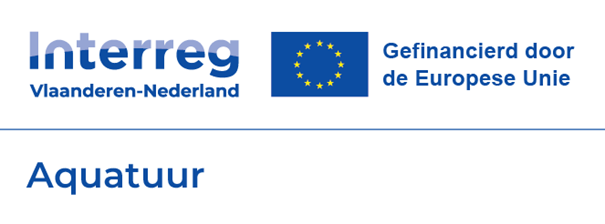Aquatuur: creating a robust water system
Flanders and the Netherlands are combining their efforts under Interreg Vlaanderen-Nederland. Flanders Environment Agency (VMM) is working on the Aquatuur project together with 9 partners from Flanders and the Netherlands. The project ambitions to increase the climate-robustness of the water system are already captured in its name, combining 'Aqua’ (Latin for ‘water’) and ‘tuur’ (from the Dutch word ‘natuur’, meaning nature). This will be done by increasing freshwater availability, based on sustainable nature-based green-blue solutions (NGBS) in the Scheldemond region.
Aquatuur: what and why?
The quality of water courses plays an important role in sustainable water use. Many water courses in the Scheldemond area fall short of the environmental quality standards in the water framework directive. This explains the great demand for more sustainable solutions.
Aquatuur increases water storage in a nature-based way, by taking account of available ecosystem services. Efforts target the following NGBSs: creek ridge infiltration, capturing water in nature areas and nature-inclusive freshwater basins. Furthermore, the availability of freshwater will be increased by upgrading various water streams. (This means that the water courses will be cleaned to enhance quality.) Using NGBSs, we contribute to stimulating various ecosystem services.
What does VMM do?
In particular, VMM envisions the building, monitoring and evaluation of a constructed wetland (CW) located at the confluence of the Ringbeek and Hertsbergebeek streams in the basin of the Bruges Polders.
In the Ringbeek, the standards for nitrogen and phosphorus are often exceeded. Particularly during the summer, after long periods of drought followed by intense rain. Since these streams flow through valuable agricultural land, VMM favours a nature-based blue-green solution in the form of a helophyte filter. A plot of 1.5 hectares has already been acquired to facilitate this activity. This area is not large enough to treat all the water in the stream, however, it does allow excess concentrations to be capped after an intense summer storm. This will be done by installing an intelligent, automated influx and outflow construction. The construction will manage the flow in and out of the constructed wetland, based on real-time water-quality measurements and forthcoming control algorithms. In order to guarantee sufficient phosphorus removal, a filter with phosphate-adsorbing material is also anticipated within the constructed wetland.

The project seeks a response to the following questions:
- How best to control the influx and outflow construction in order to optimise the expulsion of nutrients?
- What is the best size for such a system taking account of replication?
- Which control measures are required (e.g. sludge removal, mowing of water vegetation and replacing phosphate adsorbing material)?
- What is the business case for the constructed wetland with respect to the further development and optimisation of the water treatment infrastructure (extending public sewer network in the external area, disconnecting rainwater and setting up individual wastewater treatment installations) in the release area of the Rivierbeek and Hertsbergebeek?
Purpose of the project
The common goal is to create a robust water system: a system that provides sufficient freshwater at the right moment and at the appropriate quality. As well as having the ability to handle climate shocks, protect our ecosystems, while also offering the required functions and services.
Aquatuur in Europe
Aquatuur is being executed on behalf of the European Commission as part of the Interreg Flanders-Netherlands-programme, coordinated by VITO (Vlakwa).
| Project partners | |
|---|---|
| België |
VITO (Vlakwa) Ghent University Flanders Land Agency (VLM) Flanders Environment Agency (VMM) INAGRO |
| Nederland |
Province of Zeeland HZ University of Applied Sciences Municipality of Schouwen-Duiveland Municipality of Noord-Beveland |
Project duration: from 22 June 2023 to 21 June 2026.



